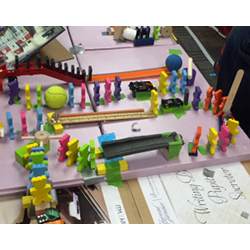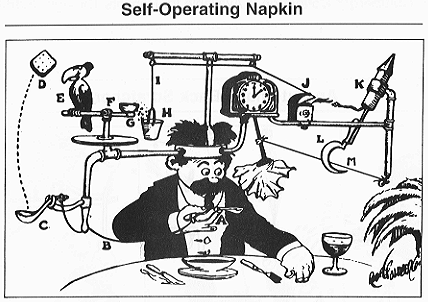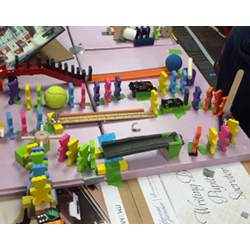
An homage to a cartoonist of the 20th century famous for overcomplicating anything he thought about is emerging as a popular 21st-century way to get students to think creatively —and humorously—about science and technology. In fact, the homage, the annual Rube Goldberg Machine Contest (RGMC), might be best thought of as a way to see the interconnectedness in many disciplines, according to the cartoonist’s granddaughter, Jennifer George.
“We believe that STEM starts here, but so do a lot of other things,” George said of the contest, which encourages students to build outrageously complicated contraptions to complete a simple task. “It brings out storytelling, art, theater, even acting. When I do Skype talks with classrooms about the contest, I ask ‘Who’s the funniest one in your class? Because the funniest kid will help make your machine funny. The best artists make the machine look great, the best storyteller makes the story of the machine sing.’
“It’s really a wonderful interdisciplinary group effort. I’ve had middle school and high school students’ parents say ‘This competition changed our child’s life. She didn’t know she liked science, and now she wants to be an engineer.’ That’s an enormous thing.”
Ad hoc origins
The contest, which executive director Kathleen Felix said drew about 320 teams in the middle school, high school, and university divisions in 2016, actually began in the late 1940s, during the peak of Goldberg’s popularity, as a competition between two fraternities at Purdue University. The first incarnation ran its course briefly and disappeared until the early 1980s, when some fraternity brothers stumbled upon the trophy from the old contest and resurrected the competition. Though the family was always involved to some extent in the latest incarnation, George said they opted to assume complete responsibility “about five years ago” after an absent-minded frat brother forgot to book a venue or perform other duties expected of an organizer.

A sample of Goldberg’s humor: a 1931 cartoon depicting
“The Self-Operating Napkin.”
Source: Wikipedia
While she started out as “the reluctant granddaughter,” George, whose official title at the contest is “legacy director,” has clearly become a pivotal figure around not only the contest, but also other components of the Goldberg enterprise. Competitors are excited to have met her; one team concluded a run of its machine this year by accomplishing the prescribed task, applying a Band-Aid brand bandage, onto George herself.
From its ad hoc origins and the family’s gradual assumption of its logistics has grown a burgeoning STEM centerpiece George hopes can compete with another STEM mainstay: robotics contests.
“If you are competing in a robotics event as a school, the person with the most money has the advantage,” she said. “With Rube Goldberg machines, all you need is a great pile of junk and an imagination.”
For 2017’s competition, the contest, which allows both in-person and online entries, featured sponsorships from Johnson & Johnson—hence the Band-Aid tie-in—and Overland Park, KS-based engineering firm Black & Veatch. Annemarie Kirby, the company’s RGMC coordinator, said the light-hearted competition serves as an entree for many more focused intentions.
“It finds the kids who are drawn toward the creativity and the fun and the humor of these machines, and then helps them make a connection to engineering and the physics behind the machines,” Kirby said. “It opens up an opportunity in their minds they might not have realized was there.”
It also serves to give Black & Veatch visibility, she said: hosting contests anywhere the global firm has a presence not only encourages STEM education, but also serves as a way to get people familiar with the company and could even serve as a recruiting vehicle for future engineers.
‘Think Like An Engineer’
Whether a participant is in his or her early teens or about to enter graduate school, a common refrain emerges: building a Rube Goldberg machine helps them learn to think like an engineer.
“It’s really helped with my ability to engineer backwards,” said Emily Weerakkody, president of the Rube Goldberg Society at the University of Illinois Urbana-Champaign, where she is a student and undergraduate researcher. “Usually, when you are trying to engineer a solution to a problem, you want to find the most streamlined, efficient way to get from Point A to Point B, and the overcomplexity of the Rube Goldberg machines helps you think of different ways to do things. It has helped with other design classes I have had to take.”
Melanie Kregg, one of the leaders of this year’s collegiate champion team from the Purdue chapter of the American Society of Mechanical Engineers (ASME), said the contest helps take her thought process out of the theoretical and into the practical. “I’m in class all day doing theoretical calculations and I never really see any of them realized, so it’s nice to go to the contests and design these steps and implement them and troubleshoot on the spot,” Kregg said. “It forces me to think outside the box in terms of problem-solving. We make a lot of assumptions when we’re doing the engineering calculations, and when all the assumptions go out the window, it’s nice to get out there and actually work with it. For me, it’s easier to see something and try to figure out what’s not working by testing and being hands-on.”
Similar sentiments come from younger competitors and their coaches. Ansgar Devadhasan, a captain on the national middle school division champion team from St. Augustine of Canterbury School in Kendall Park, NJ, said the team engineered its machine from the back end forward in a process that took six months.
“There’s something you can see at the end,” said Nora Gathje, coach of the second-place high school team from Chatfield, MN. “Whereas if you’re in a classroom studying the periodic table, when you’re finished you don’t have a tangible product to say ‘I learned this.’ With Rube, they can see they built something from nothing.”
Computational tools are not a necessity in designing a Rube machine: whereas Weerakkody said she and her teammates at Illinois may use CAD software in the initial design process to eliminate a step that may not work, others say the process is more of a build-and-test endeavor.
“The skills I can teach them aren’t necessarily computing, but I can teach them all the soft skills employers are looking for in the future,” Gathje said, “things like teamwork, creativity, problem-solving, communicating your idea and trying to get other people to buy it, and the whole idea of trying something until it works.”
Where a computing platform may come in handiest in the Rube equation is in fomenting Goldbergian thought before plans are even drawn. Veteran game designer David Fox, who may be best known for his pioneering work at LucasArts, approached George when he discovered no one had ever licensed Goldberg’s cartoons for a game. The resulting Rube Works game uses Goldberg’s cartoons to foster thinking like Rube might.
“When some teachers who have been doing this activity for years started using Rube Works as part of the unit, the kids much more rapidly got it,” Fox said. “The problem with doing it with real objects is that everything has to be perfect. With the game, to reset you just push a button, so your time is focused on creative problem solving. There’s way more reward than frustration. Once they’ve had that experience of playing three or four levels and begin to think more like Rube does, they are much more able to create a successful machine when they start using real objects.”
Serious Intentions for a Whimsical Project
Though the very idea of a Rube Goldberg machine spawns guffaws, George has very serious plans for the contest’s future. Next year, for instance, the contest will expand to hold a competition for elementary school-aged children.
“My goal, as we get more sponsors and get bigger, is to create true scholarship opportunities for schools,” she said. “This year was the first time we could give cash prizes for winning teams, which was huge, and we are finally able to create enough infrastructure online and enrich not just the rule book but also make registration easier, and help support teams in how they raise money. It’s a very labor-intensive process.”
George also said the two parts of the Rube Goldberg business—the not-for-profit education arm and the commercial licensing arm—can work in tandem to help spread the contest while keeping Rube’s name visible. The idea of rummaging around one’s basement or garage to find contraption components and then applying teamwork and creativity can be a great leveler, George believes.
“We are not nearly as big as robotics now, but we believe we actually could be just as popular,” she said. “Mostly because of the level playing field. Parity in education is so important. I never want to think a private school has an advantage over a public school if we can help it. My goal is to make it a winning situation for all kids.”
Gregory Goth is an Oakville, CT-based writer who specializes in science and technology.




Join the Discussion (0)
Become a Member or Sign In to Post a Comment